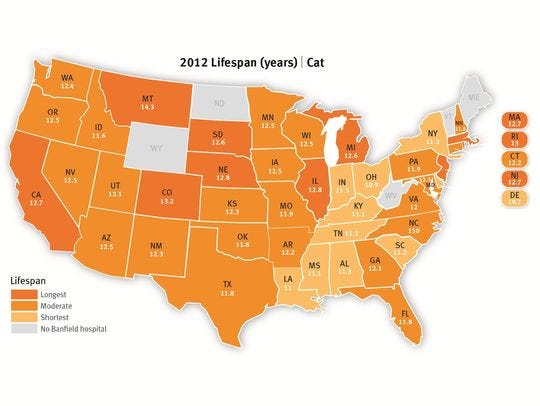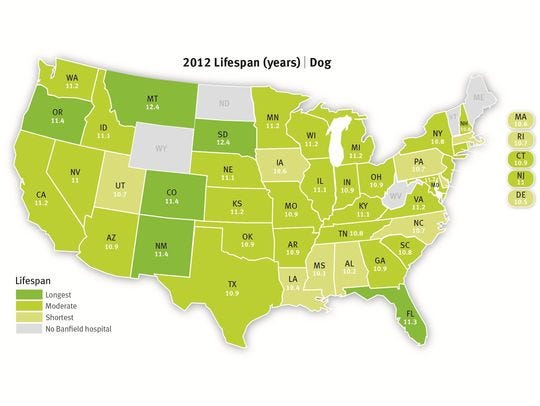A new study shows that dogs and cats have a better chance at a long, healthy life in some states than in others. How does your state rank?
Some dogs sleep outside and guard the house. Others have wardrobes and spend their day in a purse.
It’s not clear which lifestyle is pet-preferred, but a new study shows that dogs and cats have a better chance at a long, healthy life in some states than in others.
Louisiana and Mississippi have the shortest lifespan for dogs and cats, while pets in Colorado and Montana live longer, according to the 2013 State of Pet Health Report released by Banfield Pet Hospital, the world’s largest veterinary practice.
Why the difference? Experts say states with the healthiest and longest living pets also have the highest neutering and spaying rates, more pets living inside and fewer regional infectious diseases.
“It’s all about lifestyle, what your pet means to you and how you take care of them,” says veterinarian and epidemiologist Dr. Sandi Lefebvre. “There are different attitudes, different levels of education and they tend to cluster in certain areas of the country.”
Cats live the longest in Montana, Colorado, Rhode Island, Illinois and Nebraska and they have the shortest lifespan in Delaware, Ohio, Louisiana, Kentucky and Mississippi.
States with the longest lifespan for dogs are South Dakota, Montana, Oregon, New Mexico and Colorado. As for the shortest: Mississippi, Alabama, Louisiana Delaware and Massachusetts.
Southern states have high rates of heartworm because of heat and mosquitoes. Northeastern states are most likely to have Lyme disease because of the ticks that carry the disease.
State-by-state lifespans for dogs from the Banfield Pet Hospital State of Pet Health report.,(Photo: Banfield Pet Hospital)
In warmer states more pets live outdoors where they are more susceptible to these diseases. If they haven’t been neutered or spayed they will have more aggressive behaviors, says Lefebvre. “They are out roaming, fighting, looking for partners.”
Because of the roaming, unneutered dogs are more than twice as likely to be hit by a car or bitten by another animal. Unneutered cats are four times more likely to be hit by a car and three times more likely to be brought to the veterinarian for treatment of an animal bite compared to a neutered cat, the study shows.
For homes in the north, pets are more likely to be indoors because of the weather. “You do not want a sexually intact cat in your home,” Lefebvre says. “It howls, pees all over the place so spaying and neutering is obviously important.”
Adonica Jones-Parks, 45, Cincinnati, Ohio says she learned the hard way, “When I had my first cat I did not have him neutered and he was spraying everywhere – which really makes your house stink – and then he ran off for a few days. Now I know it calms them down and it’s the responsible thing to do.”
Nearly 20% of the cats in Louisiana and Mississippi aren’t spayed or neutered but in Montana and Colorado, the states with the longest lifespan, that number is closer to 8%.
Neutered male dogs live 18% longer than un-neutered male dogs and spayed female dogs live 23% longer than unspayed female dogs, according to the report.
“But even if a pet is spayed or neutered it still needs shots, training, nutrition, dental care and parasite control to live a long, healthy life,” Lefebvre says.
Julius Caeser, an 18-year-old Yorkshire Terrier lives in Rapid City, South Dakota. The average Yorkshire Terrier lives to about 11.3.
Mike Deal, 55, Julius Caesar’s owner, says Rapid City has been an exceptional place to have a dog.
“Having a hard winter kills the ticks and sand fleas and the summer doesn’t get too hot,” Deal says. “I have never seen such a pet friendly area.”
And Julius Caeser certainly lives like a king. “He has an actual seat at the table,” Deal says. “He’s never really been treated like a dog. He has always been part of our family.”
In Mississippi, the state ranking lowest for pet longevity, 44% of the dogs are not neutered or spayed, says Dr. Brandy Boykin a veterinarian in Jackson, Mississippi.
“When people come in and don’t spay or neuter their pets – they usually say they want to breed their pet or they are afraid to put them under anesthesia,” Boykin says. “A lot of Mississippi is still rural.”
Unneutered or spayed pets are also at greater risk for certain cancers, she says.
Neutering male pets decreases their chances of developing prostatic enlargement and disease and eliminates the risk of testicular cancer. Spaying female pets eliminates the risk of pyometra, a life-threatening infection of the uterus. If a female is spayed before her first heat cycle, chances of developing breast cancer drop dramatically as well, according to the report.
Pamela Cropley, 42, Staten Island, N.Y.’s first dog, Shadow, a German Sheppard Collie mix, was not spayed and developed mammary cancer.
“It came on so quickly, Cropley says. “We devastatingly had to put her to sleep. It was horrid. The doctor said that if we had just spayed her it would have significantly dropped her chances of getting the cancer.”
Now Cropley has four female dogs, all of which are spayed.
“Shadow was my first dog so it was all a learning experience,” she says.

State-by-state lifespans for cats from the Banfield Pet Hospital State of Pet Health report.(Photo: Banfield Pet Hospital)
However, cost is an issue when it comes to pet care. Prices range for spaying and neutering, but on average, dog procedures cost $278-$395 and cat procedures cost between $135-$248. Additional fees may apply based on a pet’s weight and other variables.
Read More.












